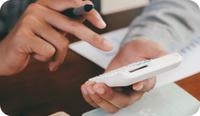Understanding SOAP Notes for SLPs and Speech Therapy

Wondering about SOAP notes for SLPs (speech-language pathologists)? This article contains information and examples that will help create speech language SOAP notes.
Doing paperwork and taking notes might not be your favorite part of your job as an SLP—but it’s a necessary one. As you grow in your career, you’ll find a rhythm for documenting the most important elements of your speech therapy sessions that works for you.
SOAP notes are a helpful way to standardize your note-taking and streamline your paperwork at the end of a long day of sessions.
What is a SOAP note in speech therapy?
The Subjective, Objective, Assessment, and Plan (SOAP) note is a commonly used note template across healthcare fields, so you can easily standardize your note-taking process and share it with other practitioners if needed.
Each note follows the same structure, and all your information is clearly laid out in digestible parts for you—or another provider—to revisit and know exactly what’s going on in a client’s treatment plan. 
Speech-language pathologists are required to demonstrate skilled intervention and progress for clients. A session note can be written in different forms, and SOAP notes are the most commonly used form. Whether you are paneled with insurance companies or private pay only, you must document your sessions. You want to protect yourself from an audit, and keep track of your work with your clients so you can track progress or change directions when necessary.
Even if you don’t accept insurance, your clinical documentation must still be defensible. If your private practice offers superbills to your private pay clients, some of those payers may ask you for additional documentation before they reimburse the client. Most importantly, SLPs must document medical necessity and skilled intervention. We must answer the question, why did this client benefit from seeing a speech-language pathologist?
In addition to medical necessity and skilled intervention, it’s also important to check the requirements and regulations of the payer with whom you’re working. For example, some payers like Medicaid and Medicare will require the total treatment time listed on the note. Other commercial payers may request additional information related to your treatment sessions on the note, such as the client’s diagnosis, the CPT code billed, or the place of service the session was held.
Finally, record keeping, which includes session documentation, is part of ASHA’s Code of Ethics. Principle 1, Rule M states “Individuals shall adequately maintain and appropriately secure records of professional services rendered, research and scholarly activities conducted, and products dispensed, and they shall allow access to these records only when authorized or when required by law” (ASHA, 2010r). In addition, your state may have additional requirements, laws, or regulations that determine what needs to be included in your notes to protect your business.
How to write SOAP notes for speech therapy
Each section in a SOAP note for speech pathology is for specific observations or assessments. The subjective section is for you to record the client’s subjective reporting of their concern. This can include their mood, their reported symptoms, other people’s reporting of their behavior, or any questions they might bring into a session. The next section, the objective section, is where you document your observations of your client’s behavior, the specific interventions used in the session and your client’s response to them, and any other quantitative information.
Then, the assessment section is for describing your analysis and interpretation of the session, and your client’s progress toward the goals defined in your treatment plan. Lastly, the plan section is for creating an outline of next steps in your client’s treatment. Here you can state anything that you are changing or adjusting for their next session.
Examples of SOAP notes for speech-language pathologists
Like most things, the more you write SOAP notes, the more quickly and expertly you’ll be able to create them. SOAP note writing is a practice, and it can be helpful to see examples that you can modify for your own needs. Below are examples of SOAP notes for speech therapy sessions that can serve as models for succinct and defensible documentation.
SOAP note example for school-age child stuttering session
Subjective: The client was on time for their telehealth session. They said, “Can we play memory today? Also, can we role-play telling people about my stuttering?”
Objective: During play, the client independently shared four communication situations when they thought self-disclosure could be helpful for reducing discomfort related to stuttering. Different scenarios were role-played such as disclosing to best friend, band teacher, general studies teacher, and school counselor. The client suggested they practice pseudo-stuttering to approximate what these situations might actually look and sound like. We brainstormed how it might feel before, during, and after self-disclosure and options for managing emotions.
Assessment: The client shared more communication situations than previously and spoke with confidence about their plan. Role-playing is a favorite activity and client is demonstrating less fear about what other people might think. The client is becoming more self-empowered and less bothered by stuttering moments. Their independent use of pseudo-stuttering was new and demonstrates increased comfort and confidence.
Plan: The client will attempt one self-disclosure conversation and report back during the next session. Continue with the plan of care and increasing client’s confidence and comfort around stuttering.
SOAP note example for preschool articulation session
Subjective: The client joined the 1:1 in-person session at the client’s preschool after circle time was finished. They ran over to me and announced, “My bunny!” while holding out a stuffed animal. Client appeared proud and happy to share the bunny and include it in the session.
Objective: Session focused on generalization of voiceless back velar /k/ in word initial position with carrier phrases. “My bunny can ____,” “My bunny has a ____” with /k/ word initial words: kick, camp, catch, cap, cat, cow, etc. The client demonstrated each action with the bunny or laid the articulation cards on the bunny.
70% (14/20) of opportunities the client produced the /k/ sound in the phrases accurately when given a gestural cue (tapping at the back of the throat to encourage a back position of the tongue).
30% (6/20) of opportunities the client produced the sound without any cues.
Continued to target /k/ word initial in phases while playing picnic. Carrier phrase was “Can I have a ____?” Initially, client produced /t/ →/k/ and benefited from a model and gestural cue. Once a model was given, client produced /k/ at the beginning of the request without a model 80% (8/10) of opportunities.
Assessment: The client self-monitored for the first time with carrier phrases. The practice with gestural cues and the repetition helped them achieve this. The client is very motivated to use the bunny stuffed animal to demonstrate actions or possessions. After a model was given in the second activity, the client demonstrated that in structured activities they can maintain the new production with back tongue placement.
Plan: Continue with the plan of care. Send a list of words with /k/ word initial to the client’s mother and describe how to incorporate the use of carrier phrases at home during play. Introduce visual cues to to assist with generalization and maintenance and reduce reliance on phonemic cues.
SOAP note example for adult voice session
Subjective: The client reports increased vocal demands since last visit, due to additional meetings at work. She notes that her colleagues commented “Your voice is back!” after her last work presentation, but that she experiences intermittent vocal fatigue during social events. She reports she has been incorporating her semi occluded vocal tract (SOVT) straw routine 3x a day for 5 minutes.
Objective: Led the client through SOVT exercises with straw in water. Client independently achieved optimal voicing in 5/5 opportunities. Introduced conversational training therapy (CTT), where client differentiated between her “husky” voice and “presenter” voice in 5/5 opportunities.
Practiced functional phrases where client achieved “presenter” voice in 8/10 opportunities with moderate visual cues. The client’s vocal effort utilizing CTT techniques was 4/10.
Assessment: The client met goals of optimal voicing to meet vocational demands, as evidenced by an improvement from vocal effort of 7/10 (“somewhat hard”) to 4/10 (“somewhat easy”). She is progressing toward carryover of SOVT strategies to meet social demands.
Plan: Continue current plan of care. Target optimal voicing in functional environments with CTT techniques. Introduce additional compensatory strategies to manage vocal load across vocational and social settings.
SOAP note example for adult swallowing session (home health)
Subjective: Was greeted at the door by the client’s husband. The client was awake, alert, and seated in the dining room. The client reported “having more energy” this week than previous. Husband noted that the client’s appetite had improved, and they are continuing to follow the diet recommendations.
Objective: The client’s current diet is puree with thin liquids. Today’s session focused on education, and training for swallowing exercises to promote safety during meals. To increase airway protection, and tongue base retraction, the client completed 30x repetitions of effortful swallow with minimal verbal cues and modeling.
To improve hyolaryngeal elevation, the client also completed chin tuck against resistance (CTAR) exercise, including 3 sets for a duration of 30 seconds each. The client was given PO trials of minced and moist texture solids. The client demonstrated a mildly prolonged oral stage, however, was able to initiate swallows without over signs or symptoms of aspiration.
Assessment: During the session, the client demonstrated improved accuracy for completing exercises, only requiring minimal assistance. The client is beginning to tolerate an advanced texture, while implementing safe swallow strategies such as small bites/sips, and alternating liquids and solids. The client continues to present with mild oropharyngeal dysphagia, and would benefit from continued skilled treatment to improve swallowing in order to safely consume preferred meals.
Plan: Continue therapy per the plan of care. Client to complete individualized Home Exercise Program, 3x daily. Plan to schedule the next session during a meal time.
SOAP note example for adult cognitive communication session:
Subjective: The client arrived 10 minutes late to session, and stated they “lost track of time.” The client’s wife also attended this session. Per wife’s report, the client is still “forgetful,” and needs frequent reminders to remember things to do.
Objective: Session focused on continued training, and implementation of strategies into functional tasks to promote participation in daily activities. The client used repetition, and note taking strategies to recall information from voicemails in 3/5 opportunities, increasing to 4/5 with minimal verbal cues to use strategies.
Assessment: The client is beginning to use external memory aids more independently in a structured environment; however, needs occasional cueing. Collaborated with the client and the client’s wife to develop a list of external supports such as use of a calendar or alarms for reminders to improve prospective memory. The client demonstrates improving cognitive skills, and will benefit from continued skilled training to facilitate carryover of skills in environments outside of the therapy room. The client and his wife were provided written education regarding use of compensatory memory aids.
Plan: Continue therapy per the plan of care. The client will plan to buy a planner/calendar, enter upcoming events for the next month, and bring the planner to the next session.
Every client is different and has different needs, so you’ll need to adapt the content of your note based on what happens in your individual sessions. But these examples of SOAP notes for speech therapy can act as a starting point as you continue to develop how to write SOAP notes for your own speech therapy practice.
Practice management software for SLPs
Run your entire speech therapy practice from one simple, secure EHR system with SimplePractice.
- Effectively manage scheduling, billing, documentation, and more
- Stay secure with a HIPAA-compliant solution you can trust
- Take your practice on-the-go with a convenient mobile app
Try SimplePractice free for 30 days. No credit card needed.
More Stories
Stay inspired
Get the latest stories from your peers right to your inbox.









